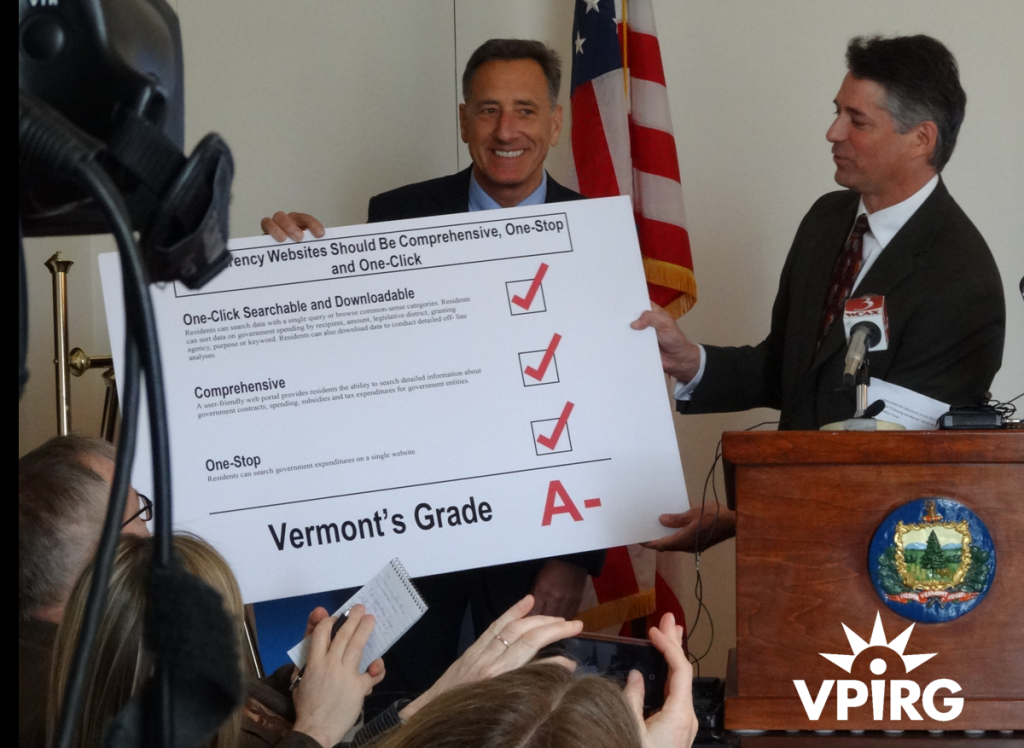New Report: Vermont Receives an “A-”
in Transparency of Government Spending
Montpelier – Vermont received a grade of A- today on government spending transparency, according to “Following the Money 2014: How the 50 States Rate in Providing Online Access to Government Spending Data,” the fifth annual report of its kind by the Vermont Public Interest Research Group the U.S. Public Interest Research Group Education Fund.
“Governor Shumlin and his team have made a real commitment to improving public access to information about government spending, and that commitment is reflected in the outstanding grade that Vermont received in this report,” said Paul Burns, Executive Director of VPIRG. “Over the last several years, Vermont state government has become much more transparent about where public money goes, providing citizens with the information they need to hold elected officials and recipients of public subsidies accountable.”
“This is a great honor for the team at the Agency of Administration that is working hard every single day to ensure Vermonters can easily access information about government spending,” said Governor Shumlin. “We’ve made great strides over the past few years to increase transparency and I’m thankful for their efforts.”
Officials from Vermont and 44 other states provided the researchers with feedback on their initial evaluation of state transparency websites. The leading states with the most comprehensive transparency websites are Indiana, Florida, Oregon, Florida, Texas, Massachusetts, Iowa, Vermont, and Wisconsin.
Based on an inventory of the content and ease-of-use of states’ transparency websites, the “Following the Money 2014” report assigns each state a grade of “A” to “F.” Described in the report as a “Leading State,” Vermont has created a user-friendly website that provides visitors with accessible information on an array of expenditures. Leading States also provide visitors with recipient-specific information on subsidy awards.
In 2013, Vermont’s Department of Finance and Management launched a new website to provide more information on contracts, economic development tax credits, and other expenditures all in a central location, earning Vermont a C+ in last year’s report. Several states have made significant progress since last year’s Following the Money, due at least in part to the helpful suggestions provided in the report. Grading standards rise each year, so states need to improve transparency each year to be a leader.
While many states continue to improve, the states that most distinguished themselves as leaders in spending transparency are those that provide access to otherwise unscrutinized areas of expenditure. Six states provide public access to checkbook-level data on the subsidy recipients for each of the state’s most important economic development programs, allowing citizens and public officials to hold subsidy recipients accountable by listing the public benefits that specific companies were expected to provide and showing the benefits they actually delivered. The most transparent states similarly provide detailed information on subsidies spent through the tax code, on economic development subsidies, and “off-budget” quasi-public agencies.”
“Open information about the public purse is crucial for democratic and effective government,” said Burns. “It is not possible to ensure that government spending decisions are fair and efficient unless information is publicly accessible.”
Vermont is one of at least eight states that launched brand new transparency websites since last year’s report, and most states made improvements that are documented in the report.
States that have created or improved their online transparency have typically done so with little upfront cost. In fact, top-flight transparency websites can save money for taxpayers, while also restoring public confidence in government and preventing misspending and pay-to-play contracts.
State spending transparency is a non-partisan issue. The report compared transparency scores with a variety of measures of which party rules the state legislative, or sits in the Governor’s office, or how public opinion tilts in the states. Neither Republican nor Democratic states tended to have higher levels of spending disclosure.
The state’s transparency website, is operated by Vermont Department of Finance and Management. To visit the site, click here: spotlight.vermont.gov.
To read the VPIRG and the U.S. Public Interest Research Group Education Fund report, click here: http://bit.ly/FollowMoneyVT
# # #

